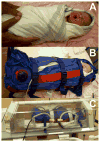Magnetic resonance imaging of the brain at term equivalent age in extremely premature neonates: to scan or not to scan?
- PMID: 22970674
- PMCID: PMC3595093
- DOI: 10.1111/j.1440-1754.2012.02535.x
Magnetic resonance imaging of the brain at term equivalent age in extremely premature neonates: to scan or not to scan?
Abstract
In the last decade, the role of magnetic resonance imaging (MRI) in neonatal care for prematurely born infants has rapidly expanded and evolved. Recent investigations addressed many of the practical issues pertaining to image acquisition and interpretation, enabling high-quality MR images to be obtained without sedating medications in preterm infants at any institution. Expanded application has demonstrated that MRI provides superior ability to assess cerebral development and identify and define cerebral injury in comparison to other imaging modalities. Term equivalent MRI results have been shown to correlate with neurodevelopmental outcomes, providing improved predictive ability over other neuroimaging, clinical or physical examination measures. Regular utilisation of MRI in this population is fundamental to gaining the knowledge and expertise necessary for rational, accurate application. Ongoing experiences will continue to shape the nature and type of information available to clinicians and families using MRI, further refining its role as a routine element of neonatal care.
© 2012 The Authors. Journal of Paediatrics and Child Health © 2012 Paediatrics and Child Health Division (Royal Australasian College of Physicians).
Conflict of interest statement
The authors declare that they have no competing financial interests or conflicts of interest.
Figures




References
-
- Holsti L, Grunau RV, Whitfield MF. Developmental coordination disorder in extremely low birth weight children at nine years. Journal of developmental and behavioral pediatrics : JDBP. 2002;23(1):9–15. Epub 2002/03/13. - PubMed
-
- Taylor HG, Minich NM, Klein N, Hack M. Longitudinal outcomes of very low birth weight: neuropsychological findings. Journal of the International Neuropsychological Society : JINS. 2004;10(2):149–63. Epub 2004/03/12. - PubMed
-
- Barre N, Morgan A, Doyle LW, Anderson PJ. Language abilities in children who were very preterm and/or very low birth weight: a meta-analysis. J Pediatr. 2011;158(5):766–74. e1. Epub 2010/12/15. - PubMed
-
- Anderson PJ, Doyle LW. Cognitive and educational deficits in children born extremely preterm. Semin Perinatol. 2008;32(1):51–8. Epub 2008/02/06. - PubMed
Publication types
MeSH terms
Grants and funding
LinkOut - more resources
Full Text Sources
Medical

